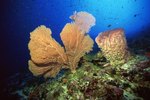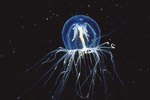
Jellyfish belong to phylum Cnidaria, alongside organisms like corals and sea anemones. Jellyfish are best known for the Medusa stage of life, when they float in the ocean with tentacles trailing. There are thousands of species of jellyfish.
Lion's Mane
The lion's mane jellyfish belongs to the species Cyanea capillata. It's a contender for the largest jellyfish. It has a bell -- the main part of its body -- greater than two meters across. The lion's mane is restricted to northern waters, including the north Atlantic, Pacific and Arctic oceans.
Portuguese Man-of-War
The Portuguese man-of-war (Physalia physalis) is a siphonophore, considered by some not to be a true jellyfish. It's actually made of a colony of four types of polyps -- gas bladder, tentacles, digestive polyps and reproductive polyps. The tentacles may trail 165 feet below the surface, although 30 feet is more the average. Their sting is extremely painful, but rarely fatal. Even dead ones on beaches can sting.
Box Jellyfish
The box jellyfish (Cubozoa spp) is extremely dangerous. They go by several other names, including marine stingers and sea wasps. They have a 10-inch bell and their tentacles trail about 10 feet. Their range includes northern Australia. They are dangerous for swimmers and can kill humans with their neurotoxin.
Irukandji
The Irukandji (Carukia barnesi) is a tiny species of jellyfish, related to the larger box jellyfish. It's only a few millimeters long -- so small that people don't see them. Their sting is initially painless. However, about 20 minutes after the sting, their venom causes intense pain and possibly cardiac arrest. They live off the northern coast of Australia.
Upside-Down Jellyfish
The upside-down jellyfish (Cassiopea andromeda) lives worldwide in the tropics. It has a mild sting, but isn't very dangerous to humans. It swims inverted, since its tentacles contain zooxanthellae. These symbiotic algae help produce energy for the jellyfish. They mostly live in mangrove swamps.
By-the-Wind Sailor
The by-the-wind sailor (Velella velella) is a small siphonophore, the same family as the man-of-war. It has a deep blue color and a "sail" on top of their bell that allows them to catch the wind. By-the-wind sailors adapt to the areas where they live; prevailing winds usually blow them away from shore. However, when winds blow in unusual directions, mass strandings can occur.
Moon Jelly
The moon jelly (Aurelia spp) is found worldwide in temperate and tropical waters. Their sting is mild and at worst irritating to humans. They grow about 18 inches wide and look like large, clear blobs of jelly. These jellyfish can live up to 25 years. Under the right conditions, they can "bloom," appearing in massive swarms.
Freshwater Jellyfish
The freshwater jellyfish (Craspedacusta sowerbyi), like the by-the-wind sailor and man-of-war, is technically not a jellyfish, but a hydrozoan. They come originally from the Yangtze River in China but have been introduced worldwide. For most of their lives, they're microscopic planuale. However, under proper conditions, they "bloom" and enter the Medusa phase, growing to the size of a penny.
Nomura's Jellyfish
Nomura's jellyfish (Nemopilema nomurai) is another contender for the world's largest, as some individuals may grow slightly larger than the lion's mane. Their bell grows to 6.5 feet in diameter. They can weigh 450 pounds. They're also becoming more common, to the point of disrupting fishing in Japan. Global warming is a possible cause of their increasing population.
Cannonball Jellyfish
The cannoball jellyfish (Stomolophus meleagris) is unusual in shape and its relationship with humans. It has a more spherical, muscular body than most jellyfish, giving it the characteristic "cannonball" shape. Their dense musculature allows them to swim more strongly than most jellyfish. Human eat them in parts of Asia, including Japan. Their bodies are dried after harvest and can be made into a soup.
References
- Animal Diversity Web: Cyanea capillata, Blayne Naylor
- National Geographic: Portuguese Man-of-War
- National Geographic: Box Jellyfish
- Animal Diversity Web: Carukia barnesi, Vishal Patel and Selina Ruzi
- Bishop Museum: Cassiopea andromeda
- Monteray Bay Aquarium: By-the-Wind-Sailor
- Monteray Bay Aquarium: Moon Jellies
- USGS: Nonidigenous Aquatic Species Factsheet: Craspedacusta sowerbyi
- National Geographic: Photo in the News: Giant Jellyfish Invade Japan
- South Carolina Department of Natural Resources: Cannonball Jellyfish
Photo Credits
-
NA/AbleStock.com/Getty Images




